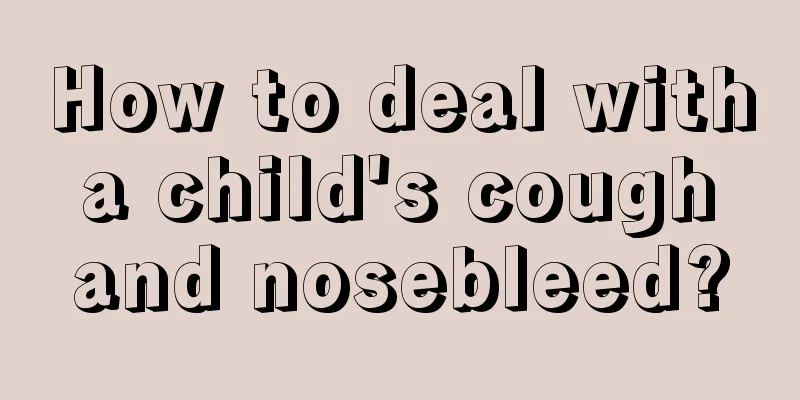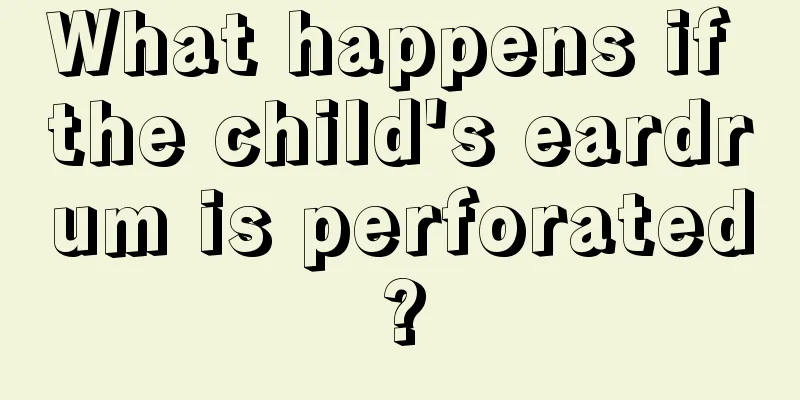How to deal with a child's cough and nosebleed?

|
Children are our hope for the future, because they carry so many of our aspirations for the future, so there is a reason why we always tend to favor children. Therefore, usually, we always try our best to make our children's lives better. However, how should we take care of children's daily life? What should we do if a child has a nosebleed? Nosebleeds are usually caused by external injuries, such as a blow to the nose. Excessively dry weather (causing the nasal membrane to crack), sudden changes in air pressure, picking the nose with fingernails, or blowing the nose too hard can also injure the nasal mucosa and cause bleeding. For some people, nosebleeds will cause blood to drip onto their mouths, chins, and clothes, which looks quite scary. There are two types of nosebleeds: anterior and posterior. The posterior type mainly affects the elderly, especially those with hypertension. In this type, blood flows from the back of the nose, down the back of the mouth and into the throat, regardless of the patient's position. In severe cases, the direction of blood flow may be both front and back. This type of nosebleed requires hospital attention. Common nosebleeds are of the anterior type, which flow out from the front of the nose. When standing or sitting, blood flows from one or both nostrils. When lying down, blood may flow into the throat. This type of nosebleed can be scary, but it's not serious. Whether nosebleeds are caused by dry climate, side effects of high blood pressure or arteriosclerosis, or accidentally breaking the nasal cavity, the tips for stopping bleeding provided below are helpful for all types of nosebleeds. Before you try to stop the bleeding, try to blow out the clot. Because the blood clot blocking the blood vessels prevents them from closing. There are elastic fibers inside blood vessels, and when you remove the clot, these elastic fibers are able to contract and close the bleeding opening. Sometimes, pinching your nose slightly after blowing it can stop the bleeding. ● Stuff gauze or wet cotton. Stuff a small piece of sterilized wet gauze in each nostril. You can also use Neo-Synephrine decongestant or Afrin nasal spray to wet the cotton and put it in the nostrils to help stop bleeding. But some experts prefer to wet the cotton with white vinegar. The acetic acid in the vinegar will burn slightly. But decongestants only provide temporary relief, and if you misuse them, you may damage your nasal membranes. ● After blowing your nose (to remove blood clots) and stuffing your nose with cotton, pinch your nostrils together with your thumb and index finger and keep pressing for 5-7 minutes. If the bleeding still does not stop, repeat the action of stuffing cotton and pinching the nose, and continue to apply pressure for 5-7 minutes. This should stop the bleeding. ● Sit up straight. If you lie down or tilt your head back, blood will flow to your throat. You can sit in a chair and lean forward (don't tilt your head back). ●Use ice compress. Ice can cause blood vessels to constrict and reduce bleeding. You can use crushed ice or a cold towel to cool your nose, neck, and cheeks. The above tells you some things you should do when a child has a nosebleed. This seemingly simple approach actually contains great benefits. I hope you will not let me down. No matter how time passes, children are always their parents' children, and parents always hope to give their children the best. |
<<: When does a child's fontanelle close?
>>: How many months is it best to wean a baby?
Recommend
What are the benefits of pediatric foot massage?
It is very popular to give babies foot massage no...
What to do if your baby has flatulence and constipation
Because the baby is still relatively young and th...
How to treat carbon monoxide poisoning in children
Carbon monoxide poisoning is a very common phenom...
What should I do if my child's teeth are rotten?
Some parents tend to spoil their babies when taki...
When is the best time for baby's skin to fall off?
After birth, a newborn baby will experience sligh...
Neonatal intestinal obstruction is a disease that cannot be ignored
For every new mother, every move of the newborn t...
Dry patches on the body like ringworm
We all know that babies have very fragile skin. T...
What to do if your baby always wakes up at night
Most families nowadays have only one child, and a...
When is the nap time for a three year old baby?
Many mothers hope that their children can get eno...
Causes of obesity in children
Obesity is a fatal blow to women, and obesity in ...
Is calcium deficiency normal in newborns?
Calcium deficiency in newborns is a common proble...
What is bacterial encephalitis in children?
Bacterial encephalitis in children is also a rela...
What are the symptoms of poor spleen and stomach in children?
Parents need to pay attention to their children&#...
How to treat sinusitis in a four-year-old baby?
Clinically, many diseases are not age-specific, r...
Newborn baby
Newborn babies need attention in care. At the sam...









